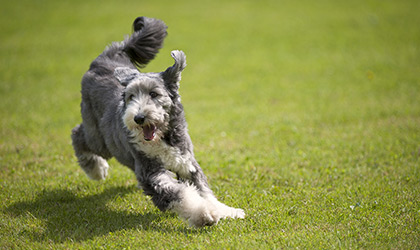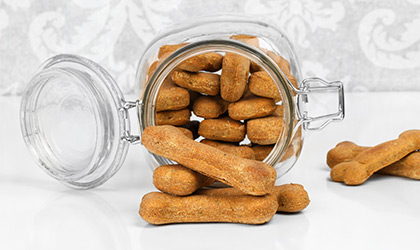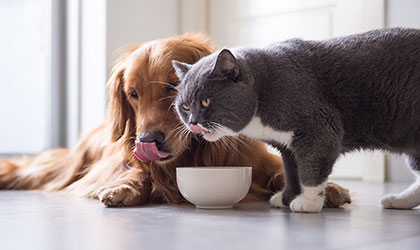
Weighing in at just 17kg and under, small breeds are the perfect lap dogs, ideal for city dwellers, and thanks to their teeny tiny size, aren’t likely to dent your bank account (too much). Despite resembling irresistibly cute teddy bears (Teacup Pomeranians, we’re definitely looking at you), small pooches are still living, breathing creatures that require plenty of TLC and affection. Problem is, many owners assume these little fur balls are much easier to care for by virtue of their size. Think again, folks! You see, just like us, every dog is an individual and will require just as much time and energy, regardless of size.
Lifespan
Adopting a precious mini hound comes with an important caveat: you must be prepared to care for him until his doggie days are over. Small breeds tend to outlive their bigger canine friends, with many enjoying life until the ripe old age of 17 years. So before investing in a tiny pal, ask yourself if you’re really ready for such a long commitment.
Diet
Compared to giant breeds, smaller pooches have exponentially higher energy requirements per kilogram of body weight. Why? Let’s get scientific briefly: a dog’s metabolic rate correlates to his total body surface area. And thanks to smaller dogs having a higher ratio of surface area to body weight than their larger canine counterparts, they need more energy per unit of weight. For this reason, they require more-calorie dense food, ideally in a slow releasing form, to support their metabolism.
To complicate matters further, small dogs have smaller stomachs (no surprises there), meaning they have less room to hold large meals. But as we’ve just established, they need more calories. The solution? A specifically formulated, highly digestible diet (be it kibble or canned food) that provides a big hit of calories in a small quantity. Oh, and whatever food you choose should be small in size too, so little mouths can eat it.
When perusing the pet food aisle for your dog’s dinner, here’s what you need to keep your eagle eye out for…
-
Quality protein to support growth, repair and energy requirements
-
Easily-digestible carbohydrates for an optimal digestive system and a slow release of energy
-
High omega content to support metabolism, coat and vision
-
Essential minerals and vitamins to support the immune system
-
Small bite-size, calorie-dense formula for tiny tums and little mouths
Of course, there’s only so much nutrition commercial food alone can deliver. So, we’d recommend adding a high-strength multivitamin and an omega-3 to your wee doggie’s diet. This is a paws-down winning combination if you don’t already have it in your arsenal. The multi will provide antioxidants, trace minerals and vitamins for all-around nourishment, while the omegas will help support your little friend’s vision, coat, and mobility.
Exercise
In general, your tiny pooch will need around 30-60 minutes of physical activity, divided into two sessions, each day. It’s up to you to find that sweet spot. Some mini dogs have tons of energy, while others enjoy living ‘a dog’s life’ as lap potatoes. A slow stroll around the block or even a game of fetch in the park will serve nicely for your tiny friend. Make sure you don’t run too fast with your little one either; there’s only so much their itty-bitty legs can take!
It’s also worth mentioning that smaller breeds have fragile neck structures – much more so than their larger canine counterparts – rendering them vulnerable to tracheal injury. To prevent this, we’d suggest investing in a chest harness, rather than a traditional lead, when walking your furry friend.
Grooming
Brushing
There’s no one-size-fits-all rule about brushing your tiny pal – frequency will differ due to coat type and length. Typically, you should brush smooth, short-coated breeds like Chihuahuas every few weeks, and double-coated or longhaired hounds, such as Cavalier King Charles Spaniels, on a weekly basis to remove tangles and loose hair.
Bathing
As with grooming, bathing your tiny fluff ball will vary between individual breeds. But let’s not complicate things, eh? To make life simpler, follow this fuss-free rule: if your pooch smells bad – like, really bad – he needs a good ol’ scrub a dub. Any owners of small breeds will know, they can be quite the energetic handful. Many won’t like sitting still for extended periods of time – let alone chilling out in the tub. For that reason, set aside 15 minutes before grooming to play with your pal and tire him out. Throw a ball, play a game of tag, or wrestle with his favourite toy – basically, anything that will exhaust him and elevate his mood before a bathing session.
If you bathe your little friend before brushing his hair, you’ll be left with clusters of knots, which are a nightmare to comb out. Before drenching him in water, take a few minutes to brush his coat, even if he’s got short hair. Grooming your furry friend won’t only remove matted areas and knots, but it’s the perfect opportunity to check for skin irritation, lumps, fleas and parasites. Top tip: if your four-pawed companion sails through grooming like a little champ, reward him with a treat.
Nail clipping
A small dog has, yes – you’ve guessed it, small claws, so nail clipping is a chore many owners downright dread. But while you may be tempted to skip this step, we’d urge you not to – it’s essential for your little pal’s health. Long nails aren’t only uncomfortable; they can actually cause your pooch to walk abnormally, which could lead to a host of joint problems. Ask your veterinarian or groomer for advice about what types of nail trimmers are best and how to use them properly. Don’t feel guilty if you can’t do it yourself; it can be a fiddly job, especially if you have a wriggly pet on your hands.
Final thoughts
There’s lots of charm in a little pooch. They’re full of personality, cute as a button, super easy to cuddle, and oh-so-portable. But being a small dog in a big world isn’t without its challenges. Just imagine how vast and intimidating it must look from down there! Thankfully, with the correct ingredients – diet, exercise and grooming – you can give these little guys the best start in life, ready to take on the weird and wonderful curveballs life may throw at them.
References:
-
RSPCA. (2018). How to look after and care for a dog. Available online: https://www.rspca.org.uk/adviceandwelfare/pets/dogs
-
Blue Cross. (2018). Choosing the right dog breed. Available online: https://www.bluecross.org.uk/pet-advice/choosing-right-dog-breed
-
Pets 4 Homes. (2018). Top tips for picking the ideal small breed dog for you. Available online: https://www.pets4homes.co.uk/pet-advice/top-tips-for-picking-the-ideal-small-breed-dog-for-you.html



